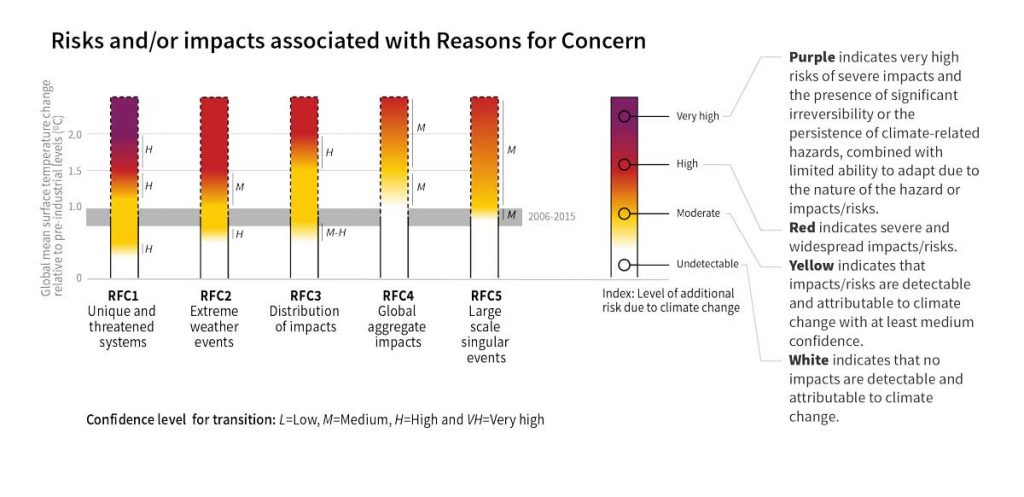The dependence of risks and/or impacts associated with the Reasons for Concern (RFCs) on the level of climate change, updated and adapted from WGII AR5 Ch 19, Figure 19.4 and highlighting the nature of this dependence between 0°C and 2°C warming above pre-industrial levels.
As in the AR5, literature was used to make expert judgements to assess the levels of global warming at which levels of impact and/or risk are undetectable (white), moderate (yellow), high (red) or very high (purple). The colour scheme thus indicates the additional risks due to climate change. The transition from red to purple, introduced for the first time in AR4, is defined by very high risk of severe impacts and the presence of significant irreversibility, or persistence of climate-related hazards combined with a limited ability to adapt due to the nature of the hazard or impact. Comparison of the increase of risk across RFCs indicates the relative sensitivity of RFCs to increases in GMST. As was done previously, this assessment takes autonomous adaptation into account, as well as limits to adaptation (RFC 1, 3, 5) independently of development pathway. The rate and timing of impacts were taken into account in assessing RFC 1 and 5. The levels of risk illustrated reflect the judgements of the Ch 3 authors. RFC1 Unique and threatened systems: ecological and human systems that have restricted geographic ranges constrained by climate related conditions and have high endemism or other distinctive properties. Examples include coral reefs, the Arctic and its indigenous people, mountain glaciers and biodiversity hotspots. RFC2 Extreme weather events: risks/impacts to human health, livelihoods, assets and ecosystems from extreme weather events such as heat waves, heavy rain, drought and associated wildfires, and coastal flooding. RFC3 Distribution of impacts: risks/impacts that disproportionately affect particular groups due to uneven distribution of physical climate change hazards, exposure or vulnerability. RFC4 Global aggregate impacts: global monetary damage, global scale degradation and loss of ecosystems and biodiversity. RFC5 Large-scale singular events: are relatively large, abrupt and sometimes irreversible changes in systems that are caused by global warming. Examples include disintegration of the Greenland and Antarctic ice sheets. The grey bar represents the range of GMST for the most recent decade: 2006–2015.
